The Best Falls Lifting Equipment For Community-Based Falls Response
Following the recent ‘Going Further for Winter‘ guidance from NHS England, which stated that “not all falls result in serious injury, and a proportion of falls can be responded to by community-based response services, supporting NHS statutory services such as ambulance services to prioritise higher acuity patients”, community-based falls response services are being set up to:
- Enhance outcomes and experience for those who fall, by improving initial response times and reducing the risk of long lies
- Improve system efficiency, focusing ambulance capacity where it is needed most and building on existing community-based provider models.
The purpose of this article is to compare the most popular lifting equipment options and give you a clear understanding of the positives and drawbacks of each, so you’re able to make the best decision for your community-based falls response services, be that Urgent Community Response Team, Community First Responders, or TEC enabled response services.
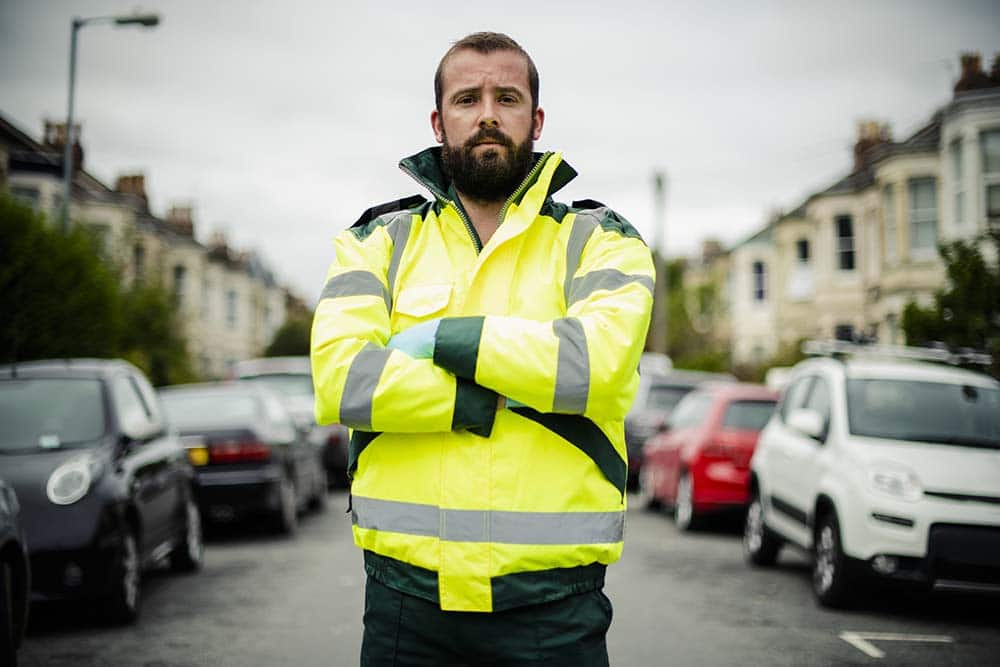
Best falls lifting equipment for community-based falls response
Mangar Elk Inflatable Lifting Cushion
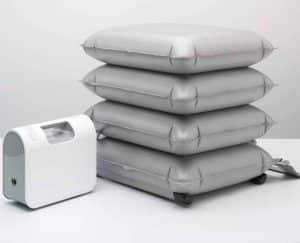
The Mangar Lifting Cushions are a range of air-powered emergency lifting cushions, manufactured by Winncare, and designed to be put under a fallen person and inflated to lift the person off the floor.
The Elk is the smallest Mangar cushion and doesn’t have a backrest, making it very portable.
Benefits of the Mangar Elk
- Portability. The Elk weighs just 3.6 kg and folds up for easy carrying, making it easily portable.
- Versatility. With a very high safe working load of 450kg, the Mangar Elk is suitable for lifting bariatric patients.
- Cost. Cost-wise, the Mangar Elk is economical and one of the cheaper options on the market.
Drawbacks of the Mangar Elk
- You have to transfer the fallen person onto the cushion, which requires much more space and manual effort from the responder, and involves a lot of hands-on pushing and pulling on the faller.
- Instability. The Mangar cushions rely on air to lift the fallen person, which means that when the cushion is inflating it is quite unstable for the patient and assistance is required from a staff member. However, when the Mangar Elk is fully inflated, it is solid and stable.
- Noise. The noise of the Mangar compressor can be distressing for some patients, particularly those with dementia. The noise can also be distressing for other family members that might be at the property, particularly if the Mangar needs to be used during the night.
- Battery life and life expectancy. The Mangar compressor’s battery lasts for 3-4 lifts, which can sometimes leave you unable to lift a fallen patient due to a flat battery. Also, the compressor’s batteries typically require replacement annually.
Mangar Eagle Inflatable Lifting Cushion
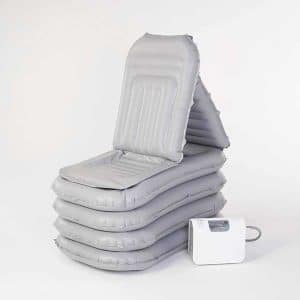
Larger than the Elk, the Mangar Eagle is the latest cushion from Winncare and incorporates a backrest to help support the back, neck, and head of the fallen person.
Benefits of the Mangar Eagle
- Versatility. The Mangar Eagle has a safe working load of 220kg, which will cater to the majority of fallers in the community.
- Supportive. By incorporating a backrest, the Mangar Eagle is designed to both sit up and lift the faller, taking some strain off the responder.
Drawbacks of the Mangar Eagle
- You have to transfer the fallen person onto the cushion, which requires much more space and manual effort from the responder, and involves a lot of hands-on pushing and pulling on the faller.
- Instability. Like the Elk, the Mangar Eagle relies on air to lift the fallen person, which means that when the cushion is inflating it is quite unstable for the patient and assistance is required from a staff member. However, when the Mangar Eagle is fully inflated, it is solid and stable.
- Noise. The noise of the Mangar compressor can be distressing for some patients, particularly those with dementia. The noise can also be distressing for other family members that might be at the property, particularly if the Mangar needs to be used during the night.
- Battery life and life expectancy. The Mangar compressor’s battery lasts for 3-4 lifts, which can sometimes leave you unable to lift a fallen patient due to a flat battery. Also, the compressor’s batteries typically require replacement annually.
Raizer M Lifting Chair
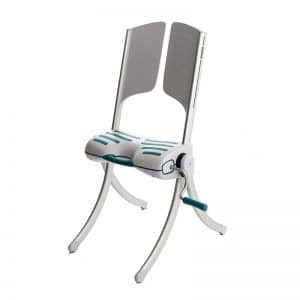
The Raizer M is a manually operated version of the electronic Raizer 2. The lifting operation is powered by a manual crank handle that slots into the side of the seating unit. Once assembled around the fallen person, turning the crank handle lifts the fallen person from a horizontal position to a seated or perched position ready to stand in 1-5 minutes.
Benefits of the Raizer M
- Reliability. The Raizer M doesn’t have any electronic components, so you will never have any issues with flat batteries, guaranteeing a reliable response every time.
- Low manual handling risk. The Raizer M assembles around the fallen person, so you don’t have to physically get someone onto it or move them around hardly at all, so there is significantly less risk of injury to staff.
- Stability. The four lifting arms keep the Raizer M stable as it lifts, giving assurance to the fallen patient and responder.
- Ease of use and training. The Raizer M is simple to use and impossible to assemble incorrectly, so responders find it easy to use, making implementation and training straightforward in your service.
- Can lift the faller to a perching position, making standing or transferring much easier.
Drawbacks of the Raizer M
- Weight of the Raizer seat unit. The seat unit weighs 8kg, which can be heavy if carried for long periods without a Raizer trolley. The Raizer Trolley is an optional extra which we recommend for community response services.
- Safe working load. With a safe working load of 150kg, the Raizer M isn’t suitable for lifting bariatric fallers.
- Requires manual cranking. Whereas the Raizer 2 can lift a faller at the press of a button, the Raizer M requires the responder to manually wind the crank handle.
Raizer 2 Lifting Chair
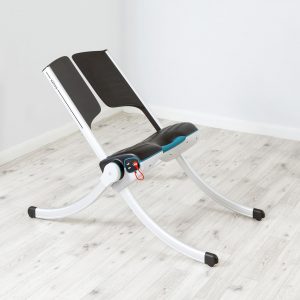
The Raizer 2 is a motorised lifting chair that is assembled around a fallen person to lift them from the floor after they have had a minor or no-injury fall.
Benefits of the Raizer 2
- Reliability. The Raizer 2 can complete 80 lifts on one battery charge and it can be left on charge in a response vehicle, so you will never be in a situation where you attend a fall and you are unable to lift the faller due to a flat battery.
- Low manual handling risk. The Raizer 2 assembles around the fallen person, so you don’t have to physically get someone onto it or move them around hardly at all, so there is significantly less risk of injury to staff.
- Enables a rapid response. Ease of assembly and speed of operation allows a fast response – typical operation including assembly is about 3 minutes.
- Stability. The four lifting arms keep the Raizer 2 stable as it lifts, giving assurance to the fallen patient and responder.
- Ease of use and training. The Raizer 2 is simple to use and impossible to assemble incorrectly, so responders find it easy to use, making implementation and training straightforward in your service.
- Can lift the faller to a perching position, making standing or transferring much easier.
Drawbacks of the Raizer 2
- Weight of the Raizer seat unit. The seat unit weighs 8kg, which can be heavy if carried for long periods without a Raizer trolley. The Raizer Trolley is an optional extra which we recommend for community response services.
- Safe working load. With a safe working load of 150kg, the Raizer isn’t suitable for lifting bariatric fallers.
- Cost. The Raizer 2 chair is the most costly piece of equipment on this list. We have an article outlining exactly how much the Raizer costs, and what affects the price – read here.
Which option is best for your falls response service?
Ultimately, the piece of equipment you choose for your service is a choice that may differ depending on your requirements. We hope this article has given you a clear understanding of the positives and drawbacks of the four most popular pieces of lifting equipment on the market, and helps you make the right decision for your service.
If you would like to talk the options through with us or book a trial of the Raizer Chair for your community-based falls response service, feel free to contact us on 01473 741144, or via the form below, and we will be happy to talk.
Related articles
Implementing community-based falls response | What are the key parts of the NHSE guidance?
Get in touch
Got a question or want to send us a message? Let’s talk.
